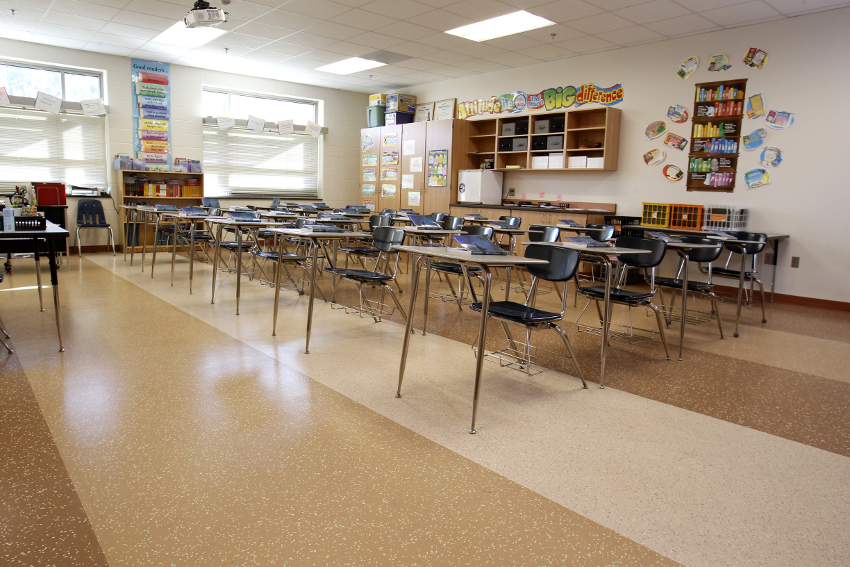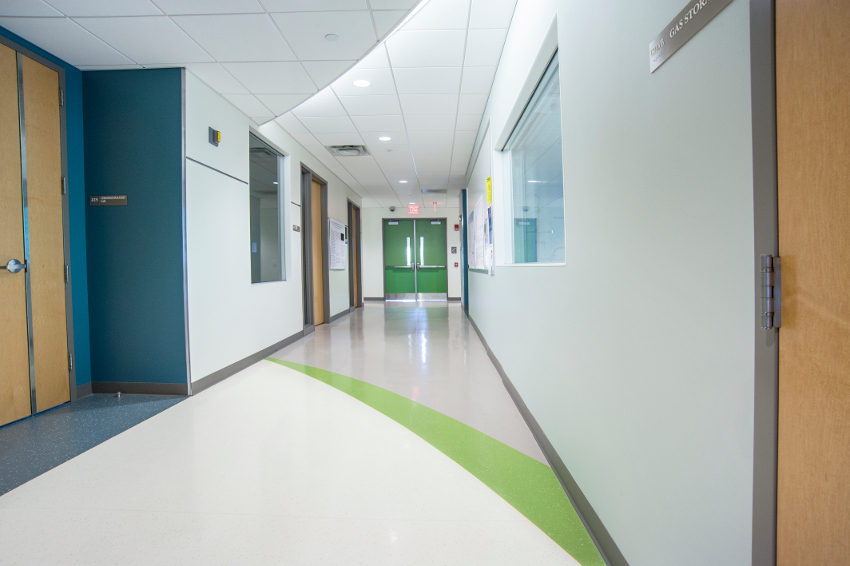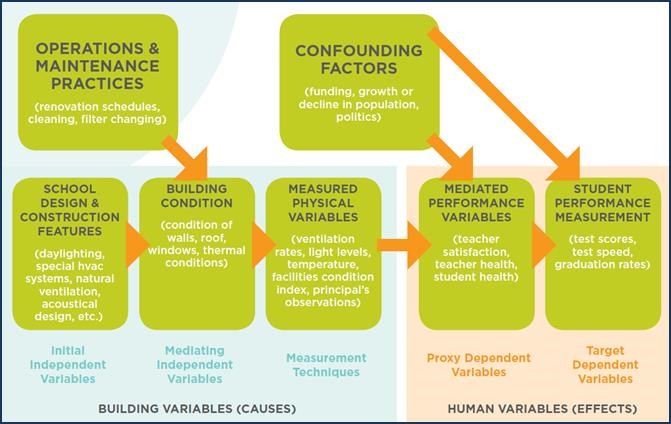Student Health. Student Performance. Student Success.
FACILITY IMPACT ON HEALTH
The concept of the “causal chain” refers to the idea that building variables (causes) lead to various human variables (effects). Research shows that “the cause-effect issue is one of the largest challenges faced when attempting to define impacts of building design decisions on health.”4 In fact, the majority of educational facilities don’t optimize learning, health, and comfort but instead try to achieve top performance at the lowest cost. Learning infrastructure is oftentimes plagued by funding and maintenance backlog, and studies have found a correlation between building conditions and student achievement. Research shows teaching methods can be undermined by inferior finish materials, with many facilities having been constructed 50 or more years ago.
Relevant findings include:
- School environment has a “substantially significant” effect on retention, satisfaction, and ability to teach.5
- In K–12, 14 million students attend schools considered below standard, with almost two-thirds of schools in need of extensive repair or replacement, leading to health related-problems.6
- In higher education, the constraint on resources means more for the renovation and daily upkeep of existing facilities given maintenance and custodial staffs have not expanded adequately to cover newly constructed space.7
The physical environment has to be up to the challenge of these new ideas. In a classroom of the “old” model—which unfortunately still exists in most schools—the rich, active, agile learning environment described above, with its moving kids and moving furniture, would lead to a noisy, chaotic atmosphere. Floors could be scratched at the very least, and often slippery with hard, unforgiving surfaces.
To provide a safe and effective foundation for a good learning environment, when a coated resilient product is specified, the flooring must perform well in several key areas discussed in the following sections: physical safety, healthy air quality, improve acoustic performance, visual and ergonomic comfort, and the practical realities of today’s educational buildings requiring low maintenance, durability, and sustainability.

Exceptional learning environments emphasize movement and collaboration. In early grades especially, students need a comfortable, safe, healthy, and easy-to-clean floor.
SAFETY AND ENHANCED LEARNING IN NEW CONFIGURATIONS
The best new designs in learning environments emphasize movement. Research discussed in the multi-author book The Third Teacher: 79 Ways You Can Use Design to Transform Teaching & Learning continues to confirm a deep connection between movement, learning and brain development. When students are allowed to move around more, the ability to concentrate actually improves. In one example, ergonomic chairs that could swivel, rock, and otherwise respond to adjustment resulted in better test scores. Even “fidgeting” is more productive for learning than sitting for long periods in rigid furniture.
In a space where teachers and students are often in motion, the slip-resistant surface of rubber flooring reduces the likelihood of falls. Its ability to absorb energy can help prevent or reduce injuries when falls inevitably occur. Rubber floors are not only safer to move on, they are safer to fall on. Added traction is particularly important in areas where large numbers of people are moving quickly most of the day, such as hallways, stairwells, cafeterias, and gymnasiums.

Nazareth College
Slip resistance can be increased by texture of the surface, but at some point there are trade-offs with cleanability, and maximum traction isn’t desirable in places where people need to be able to walk easily or move equipment. An optimum level of slip resistance for the use of the space is required. When people have confidence that the flooring is not slippery, the stress of walking and standing is reduced.
But slip resistance in flooring is complex to evaluate. Slips are often caused by the floor’s coated or waxed surface, as opposed to trips caused by factors like changes of level, damage, or obstacles. The pattern and transitions in flooring surfaces have an effect on perception. The flooring material’s surface density directly affects the posture and balance of people walking or standing on it.
Premium rubber flooring never requires a coating or finish, so the surface does not have gloss level issues that can cause visual acuity issues. When a floor is coated, we are now walking on the coating and no longer walking on the floor. Products are also available in a range of thicknesses and textures to provide precise balances of energy absorption, adequate cushioning, and firmness.
Coefficient of friction (COF) represents the resistance an object encounters in moving over another—in this case, a foot over the floor. High COFs indicate greater friction and less slip potential. For example, ice, which has a COF of 0.2, is more slippery than swept concrete, which has a COF of 0.9.
COF is often considered the only relevant component of slip resistance, but it is complicated to measure effectively and consistently. Although OSHA has no mandatory standard for COF, it has published guidelines in the past that recommend a COF greater than 0.5 as a reasonable level, while noting that there are many applications where greater slip resistance is needed. This is also the minimum value of the commonly used James Test (so named because it uses a slip-resistance machine developed by Sidney James at Underwriters Laboratories; it is also the basis for ASTM Standard D2047: Standard Test Method for Static Coefficient of Friction of Polish-Coated Flooring Surfaces as Measured by the James Machine). But not every floor is subjected to this test. In fact, there is currently no single slip-resistance test method applied consistently to both coated and non-coated resilient flooring.
As a result, two rules of thumb are useful when evaluating slip-resistance test results. First, check to see if the test was conducted by an independent company, which helps ensure accurate results. Second, flooring should be tested with its intended use in mind. For example, if the flooring requires five coats of polish, then it should be tested after five coats of polish have been applied. If the manufacturer states that no coating is required, then the floor should be tested without a coating. Some premium rubber flooring products achieve high slip-resistance ratings even immediately after cleaning, which ensures safe use of the space without delay.
The option considered most useful for comparing the COF of resilient flooring is to test using a modified version of ASTM D2047, without polish (unless the flooring requires it) and using a sensor made of dry neolite (the material of most of today’s shoe soles). This test method is currently being developed by the ASTM F06 committee. Most resilient flooring manufacturers already use this method and publish the values. The flooring manufacturer should provide testing reports, including the test method and the machine and sensors used, and if possible, testing information on pre-aged samples of the product to indicate long-term performance.
Design Affects Engagement
Recent Steelcase Education studies8 show that classrooms for active learning have a significant effect on student engagement. In the universities studied, participants reported that the new classrooms improved active learning practices and had more positive impact on engagement compared to the old classrooms. In fact, the majority of students rated the new classroom better than the old classroom; impact of the physical space significantly improved in the new classrooms for both students and faculty; and the majority of students and faculty reported that the new classrooms contributed to higher engagement, better grades, increased motivation, and more creativity.
Health, Performance, Success
Once a student graduates from high school, he or she will have spent more than 15,000 hours in school.9 This comes into focus when you consider that the specification of interior materials, especially flooring, have a direct impact on indoor air quality. Considerations include basic composition, maintenance protocol throughout the product life-cycle (need to never finish, strip, or recoat), and the inherent advantages of premium rubber flooring, which differs in quality of ingredients, manufacturing, process, surface density, and performance characteristics responding to the demands of learning—from test scores to absenteeism to reduction in allergy and asthma.
AS BASIC AS AIR
It may seem extreme to question the very air that students and teachers are breathing, but unfortunately the problems in many of today’s classrooms do start there. Research has shown that asthma is the most common chronic disorder in childhood—currently affecting 16.2 million children under the age of 18. Asthma is the leading cause of absenteeism, responsible for more than 20 million missed school days in the United States per year. The air is unfit to breathe in an estimated 15,000 American schools.
Physical products and materials in the classroom, including flooring, have a direct impact on indoor air quality in two important ways: first in their basic composition, and then in their maintenance profile throughout their product life.
First, many materials emit large quantities of volatile organic compounds (VOCs), a hazard not only to occupants of the space but also to the environment at large. The VOC emissions of an interior floor product are related to the material’s composition. Creating products that perform well but contain low or no VOCs is a challenging engineering and chemical problem that flooring manufacturers have worked to solve, with varying success.
Some materials are inherently less hazardous than others because they contain fewer synthetics, chemicals, and petroleum. Premium rubber flooring is composed of ingredients including natural rubber, a sustainable resource, and does not include previously used materials, such as tires or chemicals like plasticizers. Even very common materials, such as some forms of polyvinyl chloride (PVC), have become controversial for containing components like phthalates, which can be dangerous during manufacturing and disposal and as they age in place in buildings. Some of these ingredients are implicated in asthma and other diseases. Their use has been banned in some countries.
The second major threat posed by materials to indoor air quality is maintenance. For many flooring materials, extremely harsh chemicals are required both for daily routine cleaning and for more extensive stripping and waxing, once a year or more, when spaces must be closed for weeks at a time to complete the work. Teachers, faculty, and students are constantly exposed to strong lingering fumes, which is not healthy for anyone but especially problematic for anyone with asthma. Children in general are much more sensitive to chemical exposure than adults.
Flooring products in educational settings should contain low to no VOCs, including the adhesives used, and be completely free of substances like phthalates, halogens, and chlorine. Exceptional indoor air quality and green cleaning requirements can contribute to LEED credits.
GREENGUARD Gold certification is part of UL Environment, a business unit of Underwriters Laboratories (UL). GREENGUARD certification helps manufacturers create and buyers identify interior products and materials that have low chemical emissions.
GREENGUARD Gold Certification is one of the most stringent and rigorous indoor air quality (IAQ) certification programs in the world.
All GREENGUARD Gold certified products exceed California’s Department of Public Health Services Standard Practice for Specification Section 01350, which also tests for an additional 330 chemicals and total volatile organic content (TVOC).
Green cleaning protocol improves IAQ and can contribute to LEED credits.
Premium rubber flooring products are inherently antimicrobial, bacteriostatic, and fungistatic, providing additional protection for the health of students, staff, and visitors by inhibiting the growth and reproduction of harmful microorganisms.
In the Grand Valley School profiled in this course (see Case Study), one more unexpected benefit from the rubber flooring has been observed by district authorities over the 10 years since its installation: a significant improvement in the efficiency of the school’s HVAC system. The ability to clean the floors easily and thoroughly has translated to less dust and debris accumulating in the HVAC system, a cost saving and another contribution to exceptional indoor air quality.










